When running for President of the United States, Donald J. Trump already betrayed a shaky knowledge of the territory. He didn’t want you to think that a wall had already been built along the southwestern boundary of the United States. Now occupying the Oval Office, he seeks to convince the nation that it is in fact being built, and that the need for a permanent, impassible “wall” exist, despite Congress’s refusal to allocate new funds for a “border wall.”
But the massive show of force of cyclone fencing, regular patrols, and bullet-proof barriers set a precedent of border fencing since the 1990s, and something like a precedent for redrawing the nation in ways that are designed to resist changes in a globalized world. In ways that Trump has put on steroids as a racist divide between outsiders and “Americans,” and used as a vehicle for an “America First” agenda, as filling a need to remap strong divide between nations that would replace an “open border,” able to protect the nation, the “border wall” has become fetishized as a paradigm of the unilateral mapping of global space–in terms of actual sovereign bounds, and as a way to remap the nation’s involvement in the world and shuns international responsibilities. If the rhetorical role of the “border wall” has replaced its actuality, and mapped the proximity of the nation to the border in both duplicitous and quite dangerously simplified ways, only by returning to the border, and viewing the existing scars on its lived landscape and the traces of the migrants who have crossed it, can we unmapped the mental mapping of the border.
The effectiveness of the current complex of bollard fencing, barbed wire, steel fencing, cyclone fence, prison-wall like bars, and other obstacles has become one of the largest collections of military surplus in the United States, an accumulation of military materiel that appears designed to remind those who see it of their absence of rights. As much as a defense against globalization or immigration, the border wall stands as a fiction. Although some Americans lend credence to the idea that a barrier along the border could prevent “unlawful” entry of the country, whether such entry is in face unlawful–and what sort of balance of justice would be reinstated–is unclear. The frontier is constructed as site for denying justice, and a denial of human rights, both embodied in the a massive build-up of military material and show of force in its regime.
The construction of the border as a region that denies civil and legal rights–a “negative space” of sovereignty and liberty–has redefined its relation to the state. While the project of a wall seems to mirror the lines of a map that would separate two countries, the simple division of national zones and spatial division more of a fiction in the transborder region. The compulsion to create a map that was present on the earth–a sort of scar between two regimes–depends on defining a space outside of either state, overseen by someone who has no interest in securing rights of its inhabitants.
In this sense, Donald Trump is the perfect messenger of a circumscription of personal rights. When Trump urges the nation that no choice exists save a wall– “We really have no choice but to build a powerful wall or steel barrier”–citing that any agreement with Congress for “a fair deal” to be far off, he invokes a notion of fairness and justice that he argues it would create a sense of security–and promote a sense of national security as well as personal security–but relies on evoking the sense of fear and vulnerability that “open borders” conjure. Without any clear statistics or evidence for its value, save the magnification of border security, the need for a border wall is only a fantasy, based on an imagined. As someone who defines himself outside the political classes, and apart from an interest in preserving civil rights–or a sense of the role of government in the preservation of the nation’s liberties–Trump is perfectly suited to define himself in terms of the border wall, which he seems to be set on developing as a property.
1. The sense of justice or security is altogether absent from the landscape of the wall, and from its already heavily militarized region. The absence of place along the border is particularly striking as the accumulation of increasing obstacles to cross-border transit seem designed to preserve a sense of the integrity of the nation–and the safety of our own sense of place–in a world increasingly defined outside of the nation-state as a category, where “states” have decreasing presence or meaning for many American citizens, and most inhabitants of the globe.
In an era of the continuous extent of global space, where borders of nations are to a large extent rendered arbitrary in the virtual space of the meridians of the widely adopted Universal Transverse Mercator coordinate system–

–there seems an urgency that is more easily created of the need to define a boundary line, and to believe that the ideal border line of a national map can conjure the antiquated entity of the “nation”and defend it against the danger of migrating threats. Invoking the fear of the dangers of cross-border movements are so often epeated by the America First movement–“bad hombres,” rapists, murderers, or criminal networks, drug cartels, and multi-nationals that go beyond the current systems of state-based law enforcement, that seem designed to suggest threats that only a clear partition of territories can stop,
Migratory Routes of White Pelicans in the United States Originating from the Gulf of Mexico
Historical and Current Sites of American Black Bear in Mexico
In ways that echo the growth of border walls world-wide–only fifteen existed in 1990; there are beyond seventy–the US-Mexican border barriers already constitute one of the most massive investments in wall-building–and the most massive project of wall-building that exists. Rather than offer a spatial division that can serve to protect the nation, or reassure us of the possibility of law enforcement, the complex created around the militarized complex serves only to suspend individual rights, as much as to guarantee the law. Ie exists in an atmosphere of compromised legality, if not lawlessness, in the name of security.
Rather than see to create a secure spatial division, the border has been transformed into a deeply hostile landscape, a site seeking to erase or obliterate any sense of individuality, however much the wall is identified with justice or national protection against the threat of criminal elements. The rhetoric of wall-building that invokes justice indeed obscures the utter injustice of its construction. The 2,500 mile barbed wire fence that India is building to separates itself from Bangladesh, the US-Mexico border wall would be by far the longest such wall in the globe, as if a bald rebuttal to globalization and a declaration of American self-interest: if intended to illustrate American strength against the specter of the threat of the cross-border movement of workers, criminals, or lawlessness, it claims the ability to remove surgically the territorial United States from the dangers globalization has wrought.
In this sense, the project of wall-building is a promise to protect the sense of “place” of the nation. At the same time as our sense of the nation and our sense of place has dramatically altered for reasons beyond any individual nation, the wall reified the nation as an entity, even as the distinct nature of the nation is unclear. John Berger observed grimly, but surprisingly presciently, toward the end of his life, after touring the Occupied Territories in the Middle East, that “The present period of history is one of the Wall,” shortly after 9/11, he foretold the policing of border-crossings and humanity, ” . . . concrete, bureaucratic surveillance, security, racist walls.” The new definition of walls that are defined to separate hoary categories of race or ethnicity are increasingly evident in all too frequent attempts to create barriers of regional protection. They are based on the sense that national survival depends urgently on such massive projects of enclosure, as if such projects could be isolated from their huge effects and psychological consequences for those who might confront them on the ground.
The current emptying of words–emergency; invasion; criminality; violence; human-trafficking–make them tags to activate the border within the political imaginary, but conceal the actuality of the borderlands where the military is already present, and the lands are already quite secure–and quite vacant of habitation.

2. The place of the amassing of materials and military materiel along the US-Mexico border seems designed to create a new experience of the border, and to make it scarily real for those who might seek to move across it or to regard it as part of a zone of permeability. The exquisite photographs portraits of the wall by west coast photographer Richard Misrach has worked to document the extent to which border barriers have changed experience of the border crossing.
The barriers progressively built on the southern border of the United States reveals a new heights of the costs of bureaucratic surveillance in the name of border security. As if in a second episode of his classic Desert Cantos, begun in the 1970s, which, Geoff Dyer noted, “record the residue of human activity inscribed in these apparently uninhabited lands,” in an attempt to explore “the multiplicity of meanings in the idea of desertness.” The residue of the human is even more haunting in Misrach’s new project, and the photographs that result of human traces on the border, because they are emblems of the disenfranchisement of the borderlands that hauntingly parallel their military build-up. One might even say Misrach interrogates the landscape in his work–if the word didn’t tragically resonate so closely with the state-security apparatus on the US-Mexico border. Misrach dwells on human traces that lie around the militarization of the borer regions–from the cultural detritus left by cross-border travelers, left on migrations, the security apparatus encountered at border, and the hollow loneliness of the massive redesign of its landscape capture the expanded military-defensive complex at the border.
This evacuated land is the region that Donald Trump has come to champion as a basis for defense from national emergencies. The argument that the border is understaffed erases the rewriting of the transborder landscape that has already occurred. Misrach’s contemplation of magnificent vistas, broad traces of the inscription of authority at the border, and the reduction of the human, are truly Kafkaesque in their nightmarish reduction of the individual before the inscription of authority in its landscape.

Near Campo, CA. ©2008 Michael Dear
3. For since the definition of the US-Mexico borderline as a line of passage monitored by the border patrol back in 1924, the expansion and militarization of increasing sections of border wall is in part a spectacle of state. Their growth reflects increasing concern not only with the border, but the militarization of a border zone. But increasingly, such a zone seems sealed off form much of the country, and is rarely fully comprehended or seen, but rather invoked as a specter that needs to be expanded to establish national safety and economic security, even if its expansion has already occurred in a hypertrophic fashion, long before Donald proposed to build a “beautiful wall” to prevent crossing the US-Mexican border. If the expression reveals a lack of compassion, its problematic nature is even deeper: it reveals Trump’s peculiar identification with an apparatus of border protection, and of human containment, and the removal in his eyes of that apparatus from a discourse of rights.
Trump has celebrated the wall as if it were a new hotel and building project–asserting that he has the needed expertise to build and design it. Trump presented himself to the American press that he was perfectly suited to such a task, since building is what “I do best in life.” “I’m a great builder,” he assured his audiences, with considerable self-satisfaction, to suggest his suitability to the position as chief executive, despite his lack of political experience; defining himself apart from other political candidates in the vision of the nation that he supported, Trump added with evident satisfaction, “Isn’t it nice to have a builder?”
Precisely because he came from outside the political sphere, and outside the government that preserves and respects individual rights, he has been presented as a perfect fit for a region that lies and has developed as outside the securing of individual rights. By having a “builder” of the nation and the nation’s identity, he suggested, rather than a politician, he could guarantee the increased presence of the military along the nation’s southwestern border, and indeed promised to dedicate an increased amount of the national budget to the defense of this borderland. Precisely because Trump lacks interest in guaranteeing or preserving the rights of migrants, or rights of asylum to the nation, he is a perfect custodian and symbol of this over-militarized zone without rights. As a man without military experience, but cowed by military authority, he has become, as President, the perfect surrogate for the stripping of rights for people who try to cross the border.
Trump’s promise is that the continuous wall, to be payed for only upon completion, would remove deep worries about border security. Widespread national concern about cross-border movement since the 1990s have led to the investment to making the border more physically and symbolically present to potential migrants than it ever was–no doubt reflecting an inflated fear of illegal immigration and the dangers of their immigration by fortifying what was once an open area of transit and rendering it a no-man’s land. The number of US Agents stationed along the border has almost tripled from 1992 to 2004, according to The Atlantic, and doubled yet again by 2011, even as the number of US federal employees shrunk. Investing in the border by allocating over $4 billion each year created a concept in our spatial imaginaries we have not fully digested or mapped, or assessed in terms of its human impact, despite increasing appeal of calls for its expansion and further consolidation–even as the further consolidation of the border zone has made migrants depend on drug smugglers and other illicit trade in hopes for guarantees of cross-border passage. And in an era when a large portion of Americans seem to interact with government through the TSA—Transportation Security Administration–or NTSB–National Transportation Safety Board–the fear of external threats to the public safety seem incredibly real.
The inspired gesture of a monumental wall to be built across our Southern Border with Mexico, if a sign of weakness far more than one of strength, obliterating hope for the promise of a future, as Berger noted, intended to overwhelm and oppress as a monument to decadence and American insularity. Outfitted with not only walls, fences, and obstacles but checkpoints and surveillance cameras, the US-Mexican border has become a pure hypostatization of state power. And although Trump’s promises to build a “beautiful, impenetrable wall”–“He’s going to make America great, build a wall and create jobs,” folks repeated on the campaign, as if these were causally linked to one another–the massive construction project has been revised, as the “great, great wall” promised at rallies was scaled back to a fence and confined to “certain areas”–with the odd reassurance that “I’m very good at this, it’s called construction,” while acknowledging that the wall was “more appropriate” only in “certain areas.”
Does Trump have any sense of the massive investment of capital that already exists on the border. The promise of dedicating as much as $26 billion–even $30 billion–to such a soaring, precast concrete monument along the border, standing as high as fifty feet, was a mental fantasy, and election promise, but filled a need for ending perceptions of its permeability grew so great that his advisers see the need to warn folks “it’s gonna take a while,” but promising the ability to do so by fiat and executive order and reallocating funds for immigration services; others demur, “it was a great campaign device.”

At the same time as deporting hundreds of thousands of immigrants now deemed “illegal,” the Department of Homeland Security has effectively rendered the border a militarized zone, interrupting what had been as late as the 1980s was a relatively porous transit zone on which both countries’ economies had depended: the accumulation of capital on the border has expanded what was once a simple line to create obstacles to human movement challenging for viewers to process from a distance, or to map as a lived experience. Of course, the existence of the wall has created a blossoming of illegal trafficking, as migrants are forced to depend on smugglers to help them in their quest to cross the imposing border, augmenting the illegal activity that occurs along its path, under the eyes of the many employees that guard the expanded border zone, in a far cry from the border patrol of years past.
The accumulation of obstacles for human transit contrast sharply to the old border fences that they have long rendered obsolete. The growth of the border zone dates from 1986, when granting of “legal” status to Mexican immigrants in the 1986 Immigration Reform and Control Act (IRCA) had the consequence of redefining Mexican migrants as “illegal.” The investment in increased construction of the border over thirty years to the “illegal” immigrants who were surveilled by the U.S. Border Patrol at the highly monitored militarized border, designed to thwart unregistered immigration. The argument that the old border fence is now outdated, and contiains gaps–
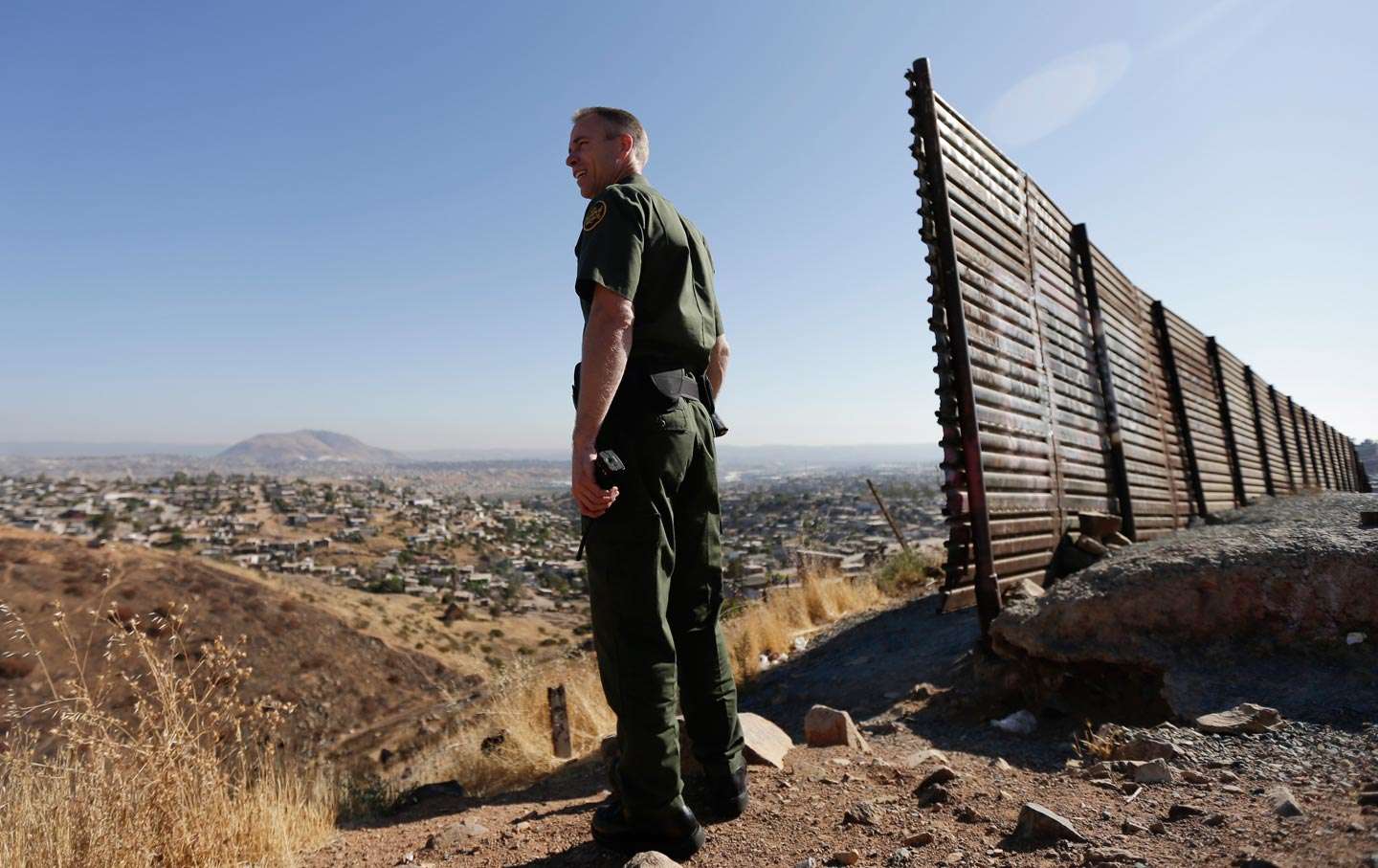
AP/Gregory Bull: Border Agent Jerry Conlin looks out over Tijuana beside old border fence
–has been demonstrated repeatedly in maps. And since the Customs and Border Protection agency dedicated to “securing the nation’s borders” has come to expand the border between the United States and Mexico to prevent any possibility of human transit, reifying frontiers in ways that are nicely stated in one side of the pin worn by the very officials tasked to secure the border by regulating cross-border movement. The mandate for U.S. Customs and Border Protection–“Securing America’s Border and the Global Flow of People and Goods”–is fulfilled by a range of devices of detection, surveillance and apprehension–attack dogs; choppers; drones; visual surveillance; horseback; speedboats; binoculars–that seem to expand an impression of total mastery over space in ways that are oddly ignore the human targets of the Agency.
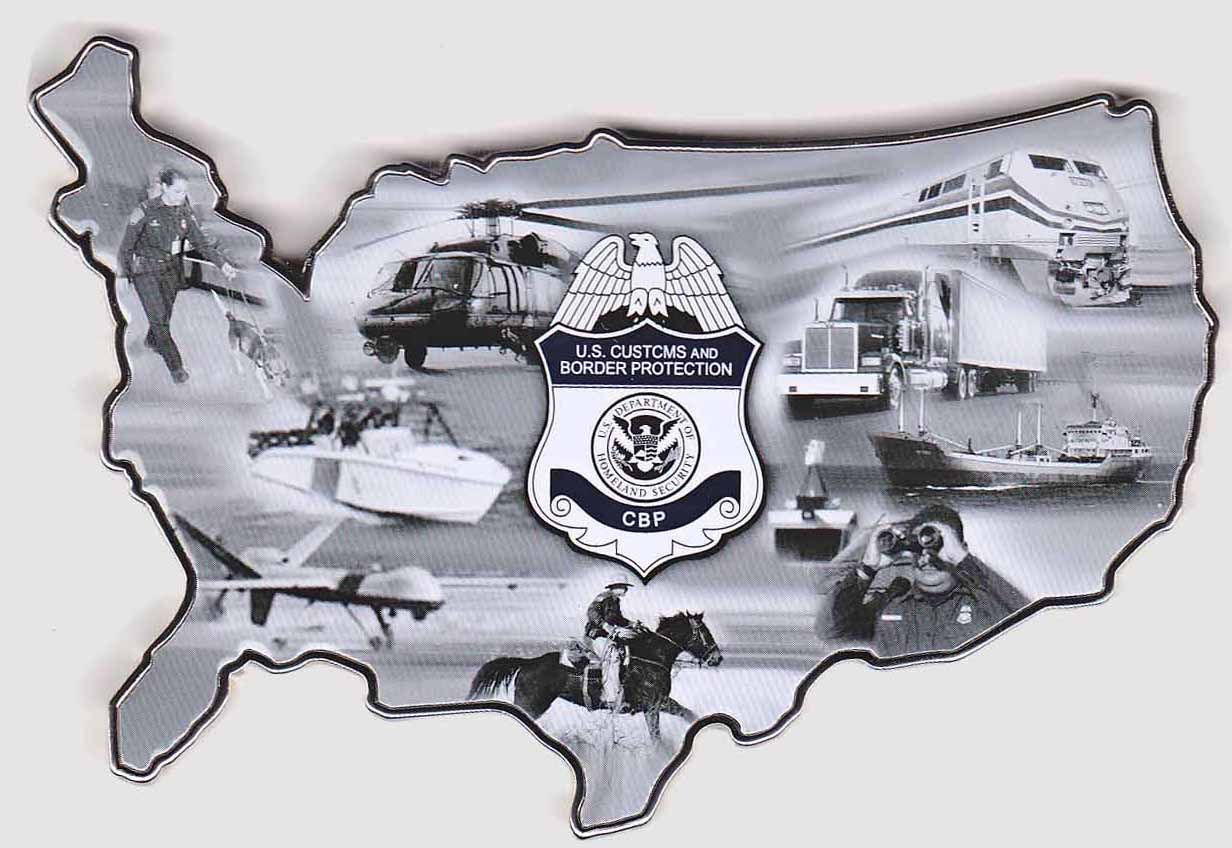
Badge of the Current Commissioner of U.S. Customs and Border Protection (Reverse)
The division of Border Services that is dedicated to secure the US-Mexico border has attracted a level of investment that multiplied the increasingly inhumane terrifying ways, as “securing the border” has encouraged a material surplus and hypertrophic expansion of the border as militarized region that exists to obstruct human transit that is undocumented. The border-zone assumes an increasingly prominent place within the spatial imaginary of Mexican migrants, as it has become increasingly accepted as a militarized–and naturalized as such–within the United States at considerable costs. What are the consequences of such acceptance of the frontier as uninhabited lands? How can one confront the consequences of its built-up construction from the perspective of the border-crosser? How can one measure the human consequences of the expansion of this outright militarization of a space between two countries who are not officially at war?
The separation of customs enforcement from border protection led an increased amount of resources to securing the material border, independent of the enforcement of customs, with effects that can be witnessed in the broad expansion of the border’s expansion as an uninhabited policed area needing to be secured in the abstract–independently from the human traffic that passes through it.

Richard Misrach/Wall, Jacumba, California (2009)
It is difficult to process the expanse or scope of the expansion of the border or the imposing barriers to border transit that is intended to prevent unmonitored migration and indeed terrify migrants from crossing the border . The experience of the surplus on the border is especially difficult to capture from an on the ground perspective, distinct from the abstract definition of the border on a map as a simple line. For the investment in the border obstacles and barriers that have themselves created the terrifying idea of sealing a border to human transit, and protecting the entry of those newly classified as “illegal”–a category that was the consequence of the IRCA, and legislation that criminalized the presence of “undocumented” Mexicans in the United States, and the growth of apprehensions of migrants after the increase in the monitoring of the border after IRCA– and the later increase of border patrols from 1994, in response to the inhumane balancing of needs for Mexican workers with fears of an increased number of Mexican immigrants, as the number of “undocumented” migrants multiplied nation-wide to new levels. The increased militarization of the border to monitor all and any cross-border transit has created a massive expansion of border fortification under the Homeland Security Dept.
The result has been to create a shocking dehumanization of border crossing as attempts to cross the border in search of a better life have grown. And the response of Richard Misrach and Guillermo Galindo to recuperate the human experience of border crossing that is erased by most maps. Recent explorations by Misrach has called renewed attention to the expansive construction of the border as a human experience migrants face and encounter, and the new landscape of border-crossing that has been created across a new no man’s land. His attention to the remains humans have left along the wall–abandoned detritus and intentional markers of cross-border transit–remap the construction of the border zone so challenging to capture in a territorial map, and capture a new sense of urgency to confront the human rights abuses that have grown with the border’s senseless expansion, and the overbuilding of border barriers and borderlands as a militarized space.
For the accumulated military surplus along border boundary is less a clear divide, than a means of creating a territory of its own within the growing border area: Misrach’s recent photographs map intensive fieldwork of the region of the border that try to comprehend the scale of its presence for those on its other side or who traverse the border zone–an experience entirely omitted from even the most comprehensive maps of its daunting scale and expansion, which reveal the growing presence that “the border,” border area and the growing expanse of trans-border regions have already gained–a scale that can in part capture the heightened symbolic role that the debates about a border fence or barrier have gained in the 2016 United States presidential election. The notion only a wall could fill the defensive needs of the United States must be protected from those Donald J. Trump labeled “bad hombres”–we stop the drugs, shore up the border, and get out the “bad hombres”–is laughable, but was a lynchpin to fashion himself as a strong male leader.
The grandiosity of the wall as a project of Trump’s megalomania led the architects at the Guadalara-based Estudio 3.14 to propose a version in hot pink, stretching along the 1,954 miles of the border, based on the work of Mexican architect Luis Barragán. The wall, including a prison to house the 11,000,000 deported, a plant to maintain its upkeep and a shopping wall, seems specially designed both to daunt migrants and offer eye-candy for Americans.

Agustin Avalos/Estudio 3.14
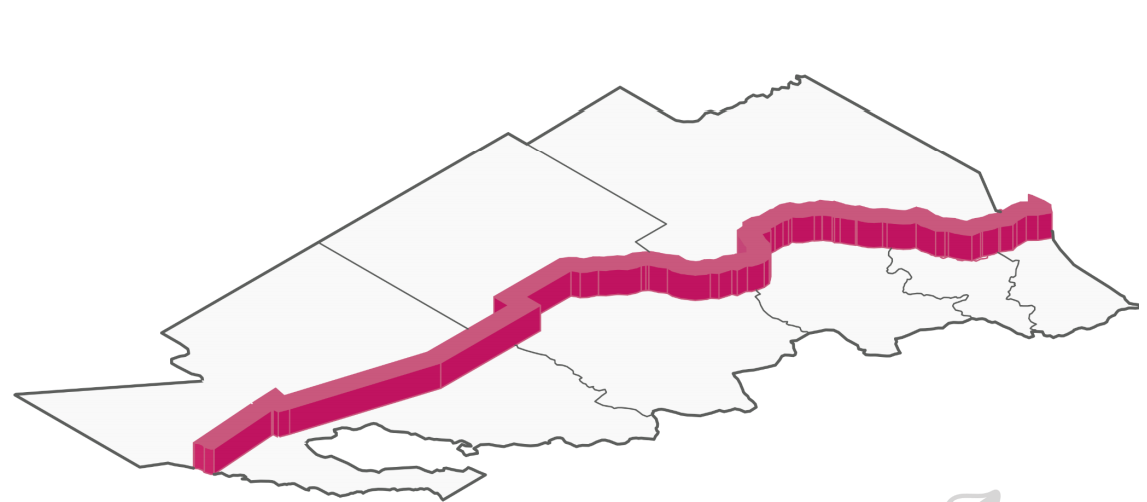
Agustin Avalos/Estudio 3.14
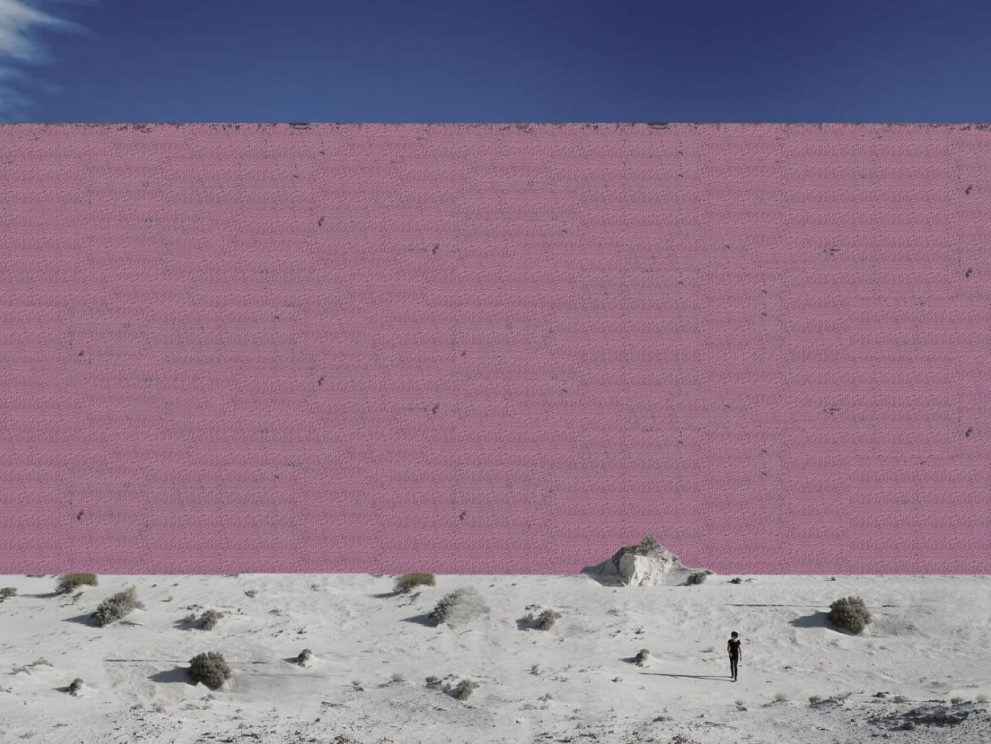
Agustin Avalos/Estudio 3.14
Indeed, such a “Prison Wall” reflects the deeply carceral function of the space of the border, whose systems of surveillance systems and technological apparatus make it less a space of transition than a site of expansive investment going far beyond the notion of border protection, both as a spectacle and expansion of territorial control. The hot pink wall offers a good substitute surpassing the expansion of border security in recent decades.
4. Indeed, as the transborder region has dramatically expanded with the expansion of cross-border trade since NAFTA in 2004, the expansion of the trans-border region has been widely neglected, and rarely mapped. The attention the photographic mapping of the human experience of border crossing–evident in the abandoned detritus and remains of cross-border transit–present a ghostly counter-map to the expanded border region.
This human map is all too often unfortunately overlooked, even with increased attention Republican presidential candidates have paid to remapping a closed border and constructing a border wall, a project that seems to erase or remove the broad area of cross-border traffic that occurs within the immense region that surrounds the physical border–whose sociological expansion is so oddly conveniently erased by any project of wall building along a region demanding to be recognized as being part of the United States.

Barajas/Sisto/Gaytán/Cantú/Hidalgo López (2014)
Most boundaries between states are regularly rendered in maps by dotted lines, as if to recall milestones–miliaria–placed at regular intervals on perimeters of lands or counties in earlier times. But the borer strip that is embedded in an expanded border area is a site of increasing surveillance that seems to engrave itself on the land. To map the proposed building of a fence along the 2, 428 mile border between Mexico and the United States reveals a the expansion of the policing of the national borderspace, erasing its past status as a transit zone across which people and goods easily moved.
In an age of globalization, borders are increasingly not only policed, but managed at a distance from their crossing lines–and increasingly invoked in Presidential elections as if they have become the primary charges of governmental management. Constructed to symbolize and symbolically represent sovereign authority, the overbuilt border seems staged a spectacle to impede human movement and to monitor and erase, individual experience, and to bolster the appropriately faceless authority of the state. Borders once the creation of shared conventions, are colonized by an apparatus designed to impose state authority on helpless people, and constructed at massive cost as artifacts that seem to exist to violently intersect with actual lived experience, confronting the cross-border motion or migration of populations, and concretizing the need for a fixed frontier as a need of the nation.

Getty Images
5. The huge popularity of advocating construction on a continuous border wall within Donald Trump’s Presidential campaign to seal the frontier along Mexico’s sovereign territory reveals the degree to which borders become a means to assert failing claims to sovereignty–even as it is an attempt to reassert the authority of an individual nation-state by unilaterally asserting its own abilities to police its bounds. How the border gained such broad purchase on the national imaginary is unclear, and may require another post–but the incommensurability of the alleged solution and the situation on the ground demands empirical evaluation. Revisiting the spectacle of the border and the suffering it creates engages broad advocacy to the continuous wall advocated alike by such presidential candidates like Trump and Ted Cruz–and the explicit violence they serve by of subjecting social life of border-crossing to surveillance in the name of national security.
And so it is apt that, in Border Cantos, a recent collaboration between photographer Misrach and Mexican-born composer Guillermo Galindo, the amassing of capital on the US-Mexico border is so eloquently documented and revealed as the brutalizing landscape that it is. More than any map is able, their collaboration bears witness to the expansion of the border’s imprint on the lives of migrants in incredibly moving ways, by asking viewers to evaluate the costs of the overbuilt structure of the fence, and assembling the artifacts and unintended traces that were found and collected about the border–traces accidentally left by actual migrants from backpacks to sneakers to books to children’s clothing and dolls to the spent shotgun shells that targeted migrants or the bicycles used to overcome border barriers–to reflect their social experience. These remains are human traces that do not appear on any actual map, of course, but are the remains of the violence that is enacted on how national boundaries are mapped–and the continued violence of the experience of border crossing that intersects with the broad security apparatus on either side of the border fence. As if to accompany Misrach’s photographs of the human geography of the borderlands–a largely empty space with few humans and only scattered human markers and material possessions–Galindo fashioned musical instruments whose playing is able to generate sounds in his own scores, specific to the surreal fraught space of the overbuilt borderlands, an eery score to accompany Misrach’s haunted landscapes, and remind us of the human presence that is so often necessarily absent from the images.
Such ephemera pale in contrast to the experience of migrants, to be sure, but offer both avenues of empathy and proofs of the brutality with which sovereign authority intersects with the mundane everyday at the border walls, in the built space that runs across the emptiness of the desert borderlands.

6. As if emblematic of the need to police the identity and safety of the nation in a time of economic uncertainty and unease at globalization and an apparent loss of jobs, the project of wall-building has become, for both Donald Trump and Ted Cruz, emblematic of the demand to rebuild the state–“Make America Great Again”–to which he claims to dedicate his campaign. The proposal to build an extended and invigorated border fence to gird the southern perimeter of the United States has come to be a potent symbol of resistance to globalization–and indeed an emblem of creating a strong country, as in “Making America Great Again“–before imagined augmentation dangers posed by the passage across porous borders, ranging from the transportation of drugs to the entrance of criminal threats or threats to American jobs. For “Make America Great Again” is a slogan that has been defined as making America great within its borders alone, irrespective of its respect for international relations or place in the world.
From the decision of Congress in 2007, in the Bush presidency, to dedicate $1.5 billion to fence construction along hundreds of miles of the border, even if the budget has steadily risen since 2013, Trump’s call to seal off the border to expand the 3,900 items of excess equipment the Customs and Border Patrol has already inherited from the U.S. Defense Department as of a year ago, in hopes to rebuild an even more spectacularly obstructive border fence.
For the division between the two nations, while serving no real interests, has become an embodiment of consensus seeming to address the “problem” of cross-border migration–without acknowledging the fate of migrants. After the opening of economic borders in NAFTA–mistakenly seen as emblematic of an out-sourcing of jobs and diminishing of national autonomy–is met by the spectacle of wall-building, as if definitively sealing the border protects national interests and illustrates strength. The spectacle of the border-wall matches the expansion of technologies of border surveillance, as an accumulation of political capital, whose spectacle of authority erases or aims to erase hopes of asylum and social life. The unmasking of the spectacle of wall-building and the increased apparatuses of surveillance combining radar, sonar, and seismic detection technologies to track and monitor cross-border movement, whose accumulation is already apparent in a surveillance networks of tower-mounted cameras, airplanes, drones and blimps that serve to create a virtual wall as a network of registration that subjects the social experience to an increasing repositioning of state-formation along our borders.
How different is the notion of the US-Mexico border from the manner that it was depicted on a pre-World War II map of 1938 of the Mexican Republic, where it is a line across which traffic flows, and the yanqui is attracted for vacations by the lure of good times–
Estados unidos Mexicanos, 1938
7. The appeal of the construction of the border is not only an artifact of the great builder, The Donald. It is a rebuilding of national space–even though it lies outside of its margins, and would offer few benefits for its actual residents, if not create a crisis of cross-border relations as a rejection of human rights designed to frustrate the countries’ relationships. While immensely popular among Trump’s constituents, the wall is a denial of migrants’ experience. The project of the ongoing restatement and reiteration of the southern perimeter of the United States is difficult to map, for it is no longer about only the boundary of the national territory, but desperately deserves to be mapped in terms of the expanding surplus of the apparatus of surveillance and build-up of border-management about the fence–a complex system increasingly incumbent to be mapped across its 1,969 miles the starts some seventy feet out in the Pacific Ocean.
Yet the proposed fence divides populations that in point of fact have long overlapped, if not sovereign jurisdiction, and continue to separate individuals from their relatives and families–subjecting social experience to an increasingly evident state. The performative construction of the border boundary wall–an apparently unending project of construction presents a spectacular symbolic construction of the state, designed to efface identities of individuals–particularly the most vulnerable identities of border-crossing migrants. As if in response to this brutal mapping of human space, the fates of migrants are the subject of a powerful multi-media artistic collaboration between photographer Richard Misrach and composer Guillermo Galindo. For if the spectacle of the US-Mexico wall suggests a gambit by a state losing faith in its authority, imposing itself on the long-sanctioned crossing of the US-Mexico border, and impeding traffic that has long existed in the border-region by enhancing the border region in a militarized cloak, as if to make invisible real problems of migration and distract from the fates of dehumanized immigrants–featureless silhouettes, as if to mirror how the experiences of most migrants are effectively erased by the growing military apparatus of the state.

Richard Misrach, Border Patrol Target Range, Boca Chica Highway, Lower Rio Grande National Wildlife Refuge
The building of the border barrier seems a screen on which to impose to impose our own images and fantasies of the state–far departing from its earlier functions as a zone of travel. Now monitored by brightly lit and carefully landscaped as a region of government control, Misrach and Galindo have depicted it as a landscape needing to be mapped as one that both abstracts and effaces the extremely precarious identities of thousands migrants, many of whose stories are daily lost and effaced by circumstances. For the wall addresses those seeking to enter the US and other developed countries–in sharp contrast to the poverty of the region, it allows them to feel the authority of the state before their attempts at transit, and pens them in as subjects of observation and not as desperate and poor. The series of photographs and musical accompaniments in Border Cantos aims to rescue their experience, allowing us to inhabit the marginal spaces into which refugees are daily forced, and recuperate the way in which migrants mark space around the border wall–as new sorts of border signs.

Samantha Sais/REUTERS (Naco, Arizona; March 29, 2013)



Richard Misrach, details from image in Border Cantos
8. The accumulation of political capital and state authority on the border is in part a growth of the massive budget dedicated to Homeland Security, designed to militarize areas of cross-border transit, but reflects the accumulation of expansive border surveillance built since 1990, but massively expanding in recent years. Since the US-Mexico boundary was first defined after the early twentieth-century border wars, the zone has atrophied as one of migrants’ deaths, and of failed transit, as much as cross-border traffic by which it was long characterized. Early attempts to police the boundary established the border line at fixed stations, distinct from the desire to prevent border crossing.
But the “Virtual Border Patrols” understanding by states like Texas, to track possible migrants by hidden cameras on private lands to track suspicious activities that ostensibly target drug traffic, such as the semi-autonomous Texas Governor’s Virtual Border Watch Program. And even though the number of those once caught attempting to traverse the enforced borderline had steadily declined during the 1990s, hitting a four-decade low in 2011–as the wall was first built–the gradual rise of apprehensions those seen as “illegal” border-crossers has grown as federal agents have sought increasing amounts of high-tech gear, in ways that stand to technologize the border, and a broader project of expanding multi-million dollar surveillance projects to track cross-border movements, and indeed treat the borderlands as if it were truly a cordon sanitaire and threat to the public good.

Yet the “border” seemed itself quite permeable and friendly, in a 1938 map–long before it had been fortified.

Oddly, the imagined fence suggests a building project, removed from its space or , but reassuring in its assuaging of the phantasma of the arrival of migrants, undocumented or illegal, cast in antiquated metaphors from outdated projects of public health as bacilli or agents of infection and disease, poised to enter the country, and in need of quarantine–rather than as situated in a specific human topography and geography of its own.

The accumulation of an overbuilt boundary exists less as an area of transit, of course, than as a dehumanization of the experience of the figure of the migrant. As it has expanded to accommodate a growing technology of border management, designed to manage and control the experience of the individual migrant, the accumulated structures of the border wall have grown from a set of obstacles to a constellations of prisons and detainment centers.
As such, it suggests a visible expansion of the idea of a surplus of state authority. Indeed, at a time when the number of undocumented border crossings has declined, the fear of the managing of a border crisis, personified in the figure of the migrant and the migrant’s movement, have led to the hypertrophied project of fence-construction. The architecture of the border zone has become symbolic of the management of the border, and of the management of the territorial state–in the face of the duration and extent of historical exchanges across a boundary once particularly permeable. In this context, the assertion of a border barrier to demarcate sovereign bounds, drawing a line which fails to reflect the actual distribution of population on the ground–but has entered their lives, independent of the deep ties that exist across the border among families, groups of migrants, or workers.
Or, even, the permeability of the border for those currently born in Mexico, which the symbolism of recent plans to rebuild a border wall all too conveniently ignores–at considerable costs to our sense of what it means to be human. Indeed, the currency that it gives to “illegal” migrants, bolstered by fears of the eventuality of a non-majority white society, and the raising of ungrounded fears about the criminality of migrants, has painted a picture of the need for the legal enforcement of border-crossing that is ungrounded and inhumane.
9. The progressive reiteration of the overly built-up boundary has defined the border as a region with its own space and its own obstacles to a transit zone. The result is both challenging to map but in their material abundance a territory apart from either country. The human costs and toll of its overwhelming construction simply cannot be communicated by a broken line of dashes any more. Indeed, rather than mapping the end of a territorial state, the array of tools of border management–surveillance cameras, trigger wires, infrared night goggles, and digital and satellite mapping tools–aimed at tracking all cross-border movement, as if to create a barrier wall around the nation to impose order on increasing unwieldy confusion between the figure of migrant, illegal immigrant, undocumented immigrant, illegal alien, and unauthorized immigrant.
The heterogeneous border barriers are built as an impassable zone of containment, inadequately symbolized by conventions which fail to register the accumulated surplus of human pain and suffering that they also create. For one can’t forget that the border barrier is fundamentally a human spectacle, even if it is also all too easily imagined as an illustration and extension of the power of the state that now exists as an independent border zone–pushed beyond the demarcation of the actual border line–the expansion of the border mirrors an attempt to monitor and control human transit across space.

If the border is the confine of the territorial state, and a line of crossing, has the wall exercised its appeal as an architecture of control and supervision that is being increasingly defined as a policed zone. At the same time as the notion of such a simple frontier has almost, as geographer John Pickles has suggested, met its end as an effective tool of border management, the expansion of the border as a zone that erases social experience and individual identity seems to inaugurate a new stage in the build-up of state involvement on its margins–evident in the Migration Stations, shelters and detention centers that have grown up about the border to detain migrants in Mexico, most arriving from other countries than Mexico, and the terrifying rise of apprehensions in recent years. Does the expression of the technologies of managing the border respond to expanded fears of the threat of trans-border migration, and a reflect a need to control human experience by border management, as much as address problems of human movement across borders–including thousands of unaccompanied children?


Pew Research/Department of Defense Declassified FOUO
To understand the border as but a fence ignores the range of practices of border management that are increasingly difficult to map–and the ways that they confront with the paths of individual migrants. How to include the experience of the migrant–and indeed the eradication of this experience–in a map? The question is important to pose, since the increasingly over-built border barriers constitute not simply an obstacle but a complex of structures and apparatuses of surveillance that reflect the power of the state, in almost performative ways, and generate a terrifying graveyard and tragic museum of lost objects and lives. How can we evoke and remember the huge material surplus of the fence, the scale of whose inhumane proportions creates one of the most conspicuous if most unseen monuments of the later twentieth century?
10. The dramatic spike of investment by the United States government on the border between the US and Mexico since the presidency of George W. Bush has been the subject of increased media attention during the 2016 Presidential Election, as Donald Trump has rehabilitated as a motif of the dire need to mobilize to protect American interests. But the monumental construction of the 1990s redefined the border as a zone which the selective criteria of maps are inadequate. The notion of sending the military to enforce the boundary, earlier a far-right proposal associated with the media-stunt by then-KKK Grand Wizard David Duke’s “Klan Border Watch” of 1975, allegedly to reduce border crossings, has been oddly rehabilitated in the public imagination by the attention that Trump, himself a builder, has dedicated to the wall, as if to boost the credibility of his transition to what he sees as political concerns. For the wall promises to be not only a massive misdirection of public funds, in a Trump Administration, as well as a boondoggle that would not only deteriorate US-Mexican relations, but fails to address the poor sanitation, public health, and endemic poverty that the neglect of the border as a region can only augment.
The border’s material surplus is less a reflection of national interests than a disaster of human geography. The vertical fencing that now runs along the Mexico’s northern border indeed serve as far more than a discouragement and imposition of space. For the heterogeneous barrier built largely by US Military creates a brutal space whose considerable human costs go neglected in any maps. The placement at great cost of border barriers of tall steel vertical bars, most filled with concrete, alternate with Normandy fencing, barbed wire fences, beside regularly smoothed paths of sand designed to track any trespasser. The United States has sought to create what was at first a very heterogeneous discontinuous space remarkable for how it has loomed so large in the American imaginary since the 1990s, when it was first redefined by border barriers inefficiently constructed from reserve military material surplus.
Continued expansion of investment in obstacles to hinder and police undocumented poor who try to enter the United States has created a no-man’s-land incommensurate with its magnification in the American public’s spatial imaginary, which condense in particularly phantasmagoric manner the twin tendencies of insularity and intervention Henry Adams saw long ago as twin currents in American history. As the Great Wall of China was re-imagined as evidence of an unbroken perimeter, the eager investment in its militarization has created a zone littered with casualties of “illegal” border crossing, from kidnappings to corpses, a rising risk of death stretching from transit points from Tijuana to Nogales to Juárez to Laredo to the Rio Grande, dramatically increasing risks of death for any aspiring immigrants attempting cross-border transit. In ways that recall the work of the anthropologist Jason de Leon, and his Undocumented Migration Project, material objects migrants who attempted or completed transit discard provide a poetic counterpoint to mute mappings of the border that erases human presence. Rendered in expansive photographs of the border’s landscape by Misrach and incarnated into sound by Galindo, and offer an opportunity to meditate on its effects on those attempting migration across its expanse–of which lost personal items, as this discarded Barbie, left by a child attempting to cross the border, offer poignant traces of human tracks that the built border seeks to overwhelm and erase.
What more civilizing function can art have than to give them voice?

11. Given its impressive and physically daunting extent, the mapping of people–the actual individuals who encounter the construction–in direct relation to the border is less easy accomplished than tracking its existence, as one can easily do through Google Earth. But how to map the material amassing of the fantasy of sealing of the southern frontier by a barrier cannot be mapped adequately without assessing its steep human costs, in ways incommensurate with quantitative, statistical and symbolic tools. The border might be best seen as a quasi-autonomously administered zone amassing built projects and obstacles created abutting a sequence of federally owned lands–
–which has gained its own identity as a porous corridor over time, or a graveyard of deaths, a no-man’s-land dividing both countries with deadly consequences–

–or rather a frontier-land, from which many avert eyes and awareness at the peril of ignoring the unique resources and ecosystems that effects both countries–up to 90% of whose population lives in fourteen urban areas, often as sister cities that are the primary paths of trans-boundary movement, across four American and six Mexican states, but whose poverty and heightened health risks uniquely distinguish the region’s settlement.

12. The promotion of an increasingly militarized policy for organizing the border in the past twenty or so years has created material surplus that realize an imagined boundary of confinement along the southwestern states, often using items of military surplus to do so, whose human effects are increasingly clear, if widely ignored. Segments of fence constructed over twenty years, with less concern for the communities on both sides of the border or changing conditions of migration, has been primarily designed to thwart undocumented immigrants and ensure a poorly conceived project of “Homeland Security.” Around the fencing lie traces of the individual itineraries of undocumented migrants who attempted to cross the monumental border boundary, but whose individual movement across borders the built complex of the border walls seem to seek to obscure.
By tracking the human possessions and signs of human presence about the fence, the collaborative art project between Berkeley-based photographer Richard Misrach and Oakland-based composer Guillermo Galindo captures, recovering the individual perspective of the border landscape and objects found along its expanse, to communicate the experience of undocumented migrants. The human remapping of the military boondoggle of the fence that so dramatically expanded during the George W. Bush’s administration provides an opportune subject for the quite productive and challenging multi-media artistic collaboration between photographer Misrach and composer Galindo. Their collaboration combines aural and visual aspects of artistic performance about the wall that serves to report on all too easily forgotten human conditions of the borderspace which cannot be confined to one national boundary. The spellbinding result is to grapple with the unmappability of the presence so misleadingly described as a “fence.” By repurposing the documentation of the presence of the discontinuous border barrier across space, the hope is to excavate a lost human geography of the multiple itineraries of those seeking to cross the borderland not so much by statistics of apprehensions, border-crossings, or patrols, but from a range of ephemera, traces and detritus found beside or in proximity to the border fence that define its liminal space–its architecture largely shaped by American authorities, but whose experience remains separate from them.
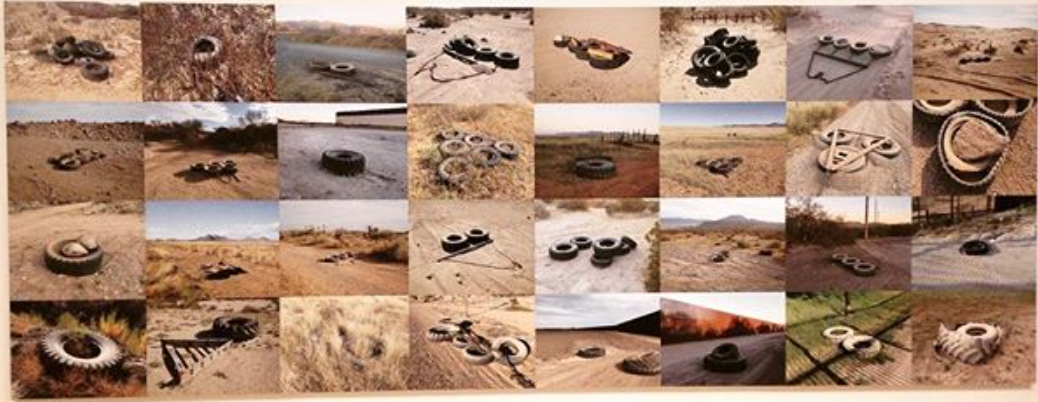
Given the extent of the border, and the lack of need for fencing around its impassable areas, it’s not surprising that only a third of the border is obstructed by fencing. Yet the accumulation of “fencing” has metastasized to monumental proportions that can’t be adequately rendered in a single or set of maps–as a Janus-faced monument of insularity and outward aggression whose violence Misrach and Galindo reveal in ways that the gaps along the actual border fences that stretch from Tijuana to Brownsville only suggest, and the absurdity of the vast imposition of such a project upon a human geography of the land.

13. The border boundaries have become a liminal space of their own in the past thirty years. And it’s become nearly impossible to map the terrifying nature of the in-between status that non-contiguous sections of imposing fencing have created across the borderland. While built to prevent “unwanted” or undocumented border-crossing, the “fence” of steel, concrete and barbed wire barriers express an odd investment in the insularity of the United States. Such order boundaries stand as odd public monuments to the absence of a border policy, symbolic constructions that quite messily link patriotism, terror, and inhumanity to improvise a “twenty-first century” border of inhumane proportions, removed from the topography of death that surrounds them but registering an increasingly militarized relation to space, national borders, and landscape on which the recent collaboration between Misrach and composer Galindo reflects, beyond the massive and indeed disorienting accumulation of capital that now exists about the border, ostensibly to apprehend drug smugglers, undocumented migrants, and increasing numbers of unaccompanied minors.
If one can try to map the number of illegal border crossings, plot the metrics of drug seizures at border crossings over time,–

Center for Investigative Reporting
or use Google Earth to chart its multiple gaps–

NPR/Matt Stiles
the accumulation of investment in surveillance apparatuses along stretches of the border constitutes the border as a zone of enacting the force of the state, as much as constituting a border. The force of enforcement means that borderlands both replace and displace the border-line, overwhelming the notion of a boundary that simply divided national states.
14. The human geography by which border barriers so violently intersect with spatial itineraries of undocumented migrants remain impossible to adequately comprehend. The set of non-contiguous fences that were first erected along the border since a small, fourteen-mile long section of welded steel was built south of San Diego in 1990 have come to exert an excessive force on absent individuals as well as occupy a large place in the nation’s spatial imaginary. Their prominence in the public imagination is driven by a material surplus that has accumulated with state funding, and was reinvigorated by the Homeland Security Department and again by the 2005 Secure Border Initiative, and filling an ever-growing insatiable demand for manufacturing surveillance on the borderland. Despite some questioning of the limited effectiveness as obstacles to deter cross-border traffic, the barricades seem symbolic constructions of strength, built from portable touchdown pads remaining from the Vietnam war or concrete poured around rebar, in an never-ending art project of inscribing authority directly on the land.
Without clear ways of addressing an imagined influx of immigrants–in fact, often unaccompanied children–the architecture of the desolate militarized borderland is constructed without an eye to human consequences or the human habitation of the land. The architecture of the border marks an uninhabited zone and in-between space. It is filled with ghosts by their eerily stark appearance, and a negative landscape by the sheer force of their surplus materiality, an eerily historical accumulation born out of desperation and frustration. Despite the demands for increased border-barrier building on the grounds of national security, adding additional sections of “fence” in the states of California, Arizona, New Mexico and Texas, mandated in the 2006 Secure Fence Act, signed to “protect the American people,” fence of chain-link pedestrian fencing and vehicle barriers seem a monument against border-crossing,supplemented by video surveillance, aerial drones, and satellite surveillance, incorporating, sealing off the southern edge of the country in a deeply misguided attempt to control human passage and lives.

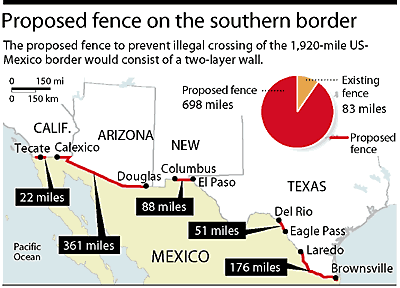
While repeatedly re-introduced since the Bush presidency by Republicans, the plans for augmented building along the border oddly disregard the continued attempts of migrants to flee poverty, and only seek to criminalize the tens of thousands Central Americans who attempt riding the roofs of cargo trains annually to traverse Mexican lands from its southern border by the shortest paths possible.
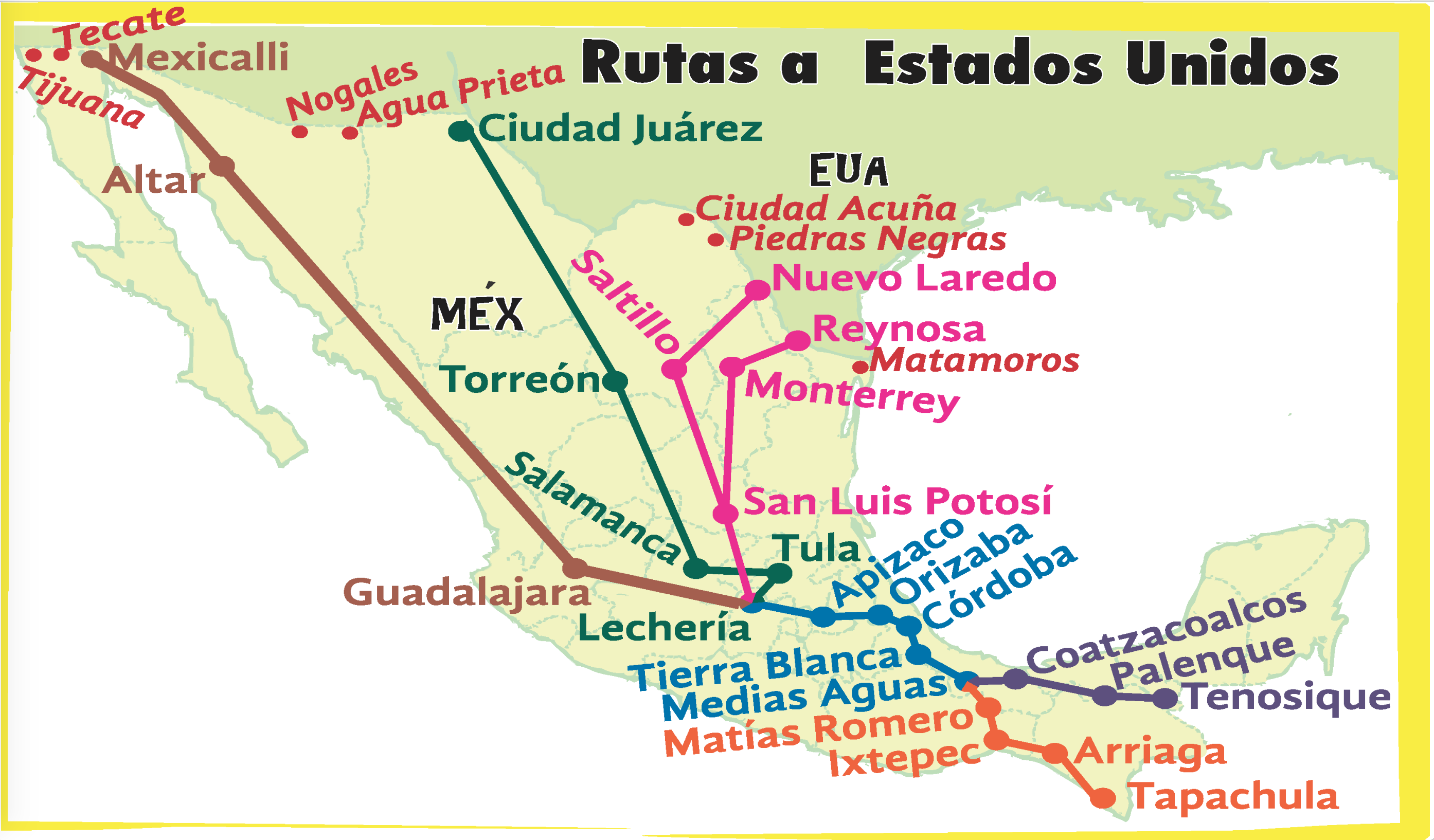
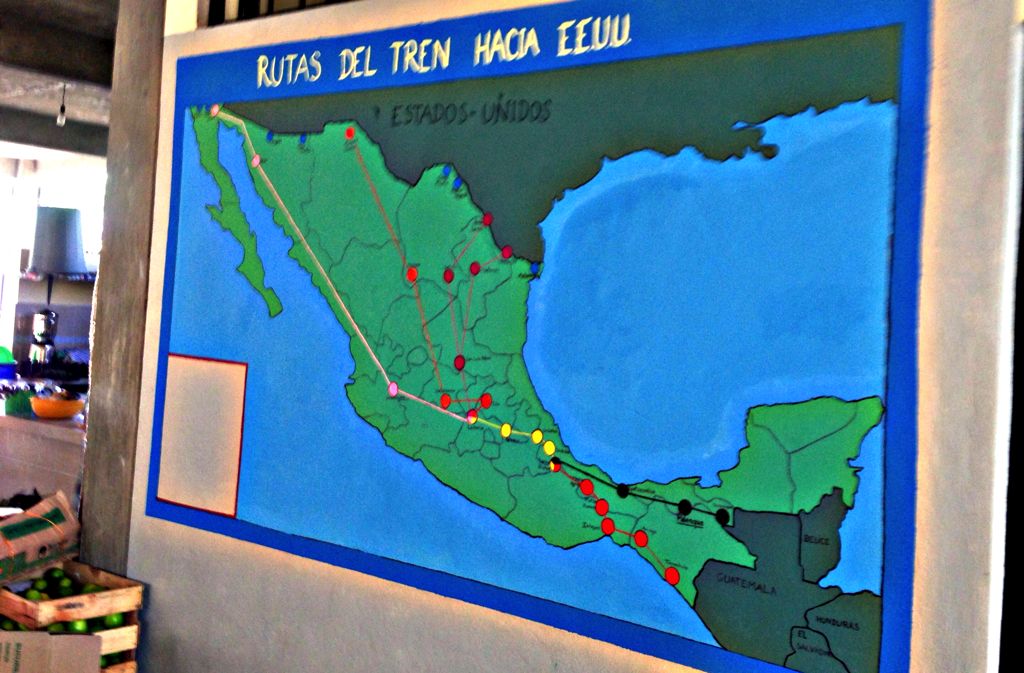
Rather than seek to cross at any point in the border–or to undertake to cross the desert “in an effort to enter the United States”–the historical routes of central American migrants who have sought to enter the United States from Mexico in recent “caravans” seeking asylum in the United States have arrived at established points of entry, in ways that exist along the border. Yet the fears of a flow of human traffic and traffickers has been presented as a need to even further expand miltiary presence along the southwestern border.
G2 Assessment of Caravans’ Progress/WOLA Defense Oversight Research Database (2018)
13. The imposing presence of the rebuilt barrier of the boundary offer a record of the increasing danger of traversing the border as undocumented migrants, evident abundant lost objects and material records abandoned by would-be migrants–bicycles, personal possessions, clothing, and talisman, and the improvised scarecrows, as well as tragic human remains that are often littered around them. This counter-accumulation of personal remains provide traces of the routes of attempted migration.
The human costs of migration continue to escalate annually given the absence of a clear policy of border security, and the growth of a range of dangers including kidnapping, sexual violence, heat exhaustion, dehydration, or drowning, that make any tabulation of the human costs of smuggling, drug traffic, or human trafficking nearly impossible to be comprehensive. And so, even as we turn the other eye to the increased human risks of immigration, investment expands in a policy of border fortification and militarization, ignoring the culture of violence that has emerged as if openly sanctioned in the heterotopia of the US-Mexico border zone, where multiple regimes of military enforcement overlap.

Richard Misrach, improvised human effigies along California-Mexico Borders, from Border Cantos
Despite the elusiveness of the possibility to ever monitor cross-border traffic in a comprehensive fashion, or to surveil those who attempt dangerous border-crossings, the costly security apparatus and border walls have created a material surplus that has so quickly accumulated that it seems to substitute for lack of an adequate border policy. Indeed, at times the wall has become a site of the commemoration of the men, women, and children who have died or been killed trying to traverse the political boundary, in one act of resistance to the failure to frame an adequate immigration policy, using it as a surface to call for needed reforms and to commemorate the many who died while crossing, and reclaiming the 15-foot-high wall of corrugated steel as a surface for commemoration of the hundreds of disappeared who have died attempting transit to the United States. The result is a transformation of the violence of the border barriers and surveillance apparatus from a negative space to a site of protest, but also a monument of remembrance, mourning, and public introspection possessing sacred qualities of its own.

But the conversion of the wall to a site of public mourning is only partially comes to terms with its massive prominence and permanence of this obstacle to those attempting to flee poverty. The accumulated obstacles interposed along the border and between border cities constitute a deep humanitarian concern, as numbers of apprehended non-Mexican immigrants attempting cross-border transit in south Texas have reached new heights.
The constructions that define the landscape of the border is less striking for its coherence than the variety of dehumanizing barriers that seek to block or impede undocumented migrants by creating a terrifying no-man’s land along routes that migrants travel. Scarring the landscape in indelible ways, they create a negative in-between space on the edge of the nation that bodes sinister for how we treasure our sense of civil society, but reflects the power of the sovereign state, rather than its “responsibility” to secure “our” boundaries. The massive surplus of the newly instituted boundary barrier that dates only from 1990s, despite being surveilled by observation towers and monitored by border patrols of 1500 National Guardsmen, motion sensors and cameras, and sections of a long-running fence constructed costing over $1 million dollars a mile, the effort to “secure our borders” offers evidence of the lack of humanity about how we draw border lines. If an impressive investment, it remains a limited deterrent. President Obama reaffirmed the federal government’s “responsibility . . . to secure our borders” in 2010, but the barricading of almost a third of the 2,000-mile international border fencing reveals a surplus of material objects, concrete-filled rebar and stopping posts that only deflect attention from the plight of migrants by a daunting show of force and of our inhumanity.
14. Around the negative space of the border-barrier, migrants are not only expose themselves to artillery, but enter a militarized space clearly separated from and cordoned off of civilian space by their very surplus. The multibillion dollar project affirms an illusion of continuity and a territorial divide more than constitute a reality, although they are imagined as a territorial divide. Materializing the border long patrolled. In those sections of eighteen-foot high fencing mandated by the Secure Fence Act of 2006 of George W. Bush’s presidency to decrease “security threats” near urban areas and historical border-crossings in the Rio Grande Valley, the 130 mile long stretch of fences create a zone distinguished by being absent from civil space. Although some advocate benefits in extending these imposing sections at unwarranted human and financial cost across the entire territorial boundary line, the odd place created by existing “segmented fencing” of twenty-one separate stretches in the Rio Grande to thwart the itineraries of otherwise undocumented migrants create a non-space across a border-zone only recently documented or explored for the space of death that it creates for the undocumented.
The “fence” are actually fences, but sectors of fence and quarantine, built since 1990 to discourage migrants in improvised fashion, whose largest areas of barriers are in fact proposed. The fence is a “non-place” and not an actual wall, attempting to obstruct the thousands of attempted desert crossings that occur every week and year–all too often charted from a technocratic perspective at a remove from human experience.

If the stretches of reinforced fences built from Tijuana to Nogales to El Paso to Loredo and to the Rio Grande and Brownsville improvise impassible regions in response to migrant routes. They create eerily inhumane spaces on much of the border, and expand an alternative routes to evade the expansive expression of force along the borderline–often through more treacherous environments, and not necessarily above ground.

The paths of individual itineraries are implicitly juxataposed against the ugly architecture of the border fences in the sequence of atmospheric photographs Misrach created over multiple visits to the fences, which cannot help but evoke the journeys of undocumented migrants, exhibited paired with compositions Guillermo Galindo performed with instruments made from objects Misrach discovered near the fences. In an attempt to capture the negative space created by massive investment of public funds along the borderlands, Misrach has recreated their expansive landscape recontextualize these improvised massive material border boundaries to provoke questions about how they intersect with the lives of actual migrants, focussing on the traces migrants left near to the fences in personal objects from which Galindo has created pieces that return our attention to these haphazard lost fragments of migrant’s attempts to traverse the border. The recovery of these individual paths are not mapped as itineraries, but called to memory in deeply evocative ways that, as the wall of individual crosses, bear testimony of the many migrants who desperately dedicated themselves to circumventing their architectural confines.
15. Photography is not cartography, but provides a record of the scars on the land that were drawn by mental maps. Tthe sections of fencing Misrach has studiously photographed in multiple voyages map the border barrier from the position of the undocumented migrants, reminding us of the vantage point of the individuals whose itineraries they are built to thwart by inviting us to re-inhabit the landscape of the boundary fence. Misrach’s expansive photographs of the border structures, crafted as inimitable atmospheric open views, offer an aesthetic counterweight to the oppressive structures of the US-Mexican border; they also help to insert people in an abandoned landscape, and conjure the multiple individual itineraries of humans that the border barriers seek to end. As such, they eloquently empty the barriers’ oppressive authority.

Richard Misrach, “Near Nogales,” from Border Cantos

Richard Misrach, Border Cantos
16. Misrach’s evocative photographs invite us to encounter their built surplus to reexamine the huge human costs of its construction, forcing us to question the “value” they create by dwarfing them in the expansive landscape. Far more effectively than by maps alone, they create important settings that help viewers to consider the negative spaces that they create for the very undocumented migrants by which they seem inescapably haunted.
The spaces Misrach photographed don’t map onto clear sections of steel fence, but seem to capture the ghosts that haunt the barrier, even as they lightly undermine the oppressive authority of the costly material constructions that see a vain show of force, linked with technologies of surveillance in the name of Homeland Security–but which encourage ingenious if dangerous evasions in tunnels linked to storm drains, extensive burrows, bicycles used to escape monitors, or foot voyages across desert lands. Indeed, such means of underground transit or evasion are increasingly common, and would not be clearly addressed in Trump’s project of reinforcing the boundary with an unbreachable wall.
17. The provocative collaboration between Misrach and Galindo serves as a documentary to capture the ghosts that inhabit the zone of boundary barriers, by deconstructing its imposing architecture and considering the impact of its architecture on human lives. Photographs and composed music based on fragments Misrach found along the barrier re-present the surrounding landscape by the physical traces left by undocumented migrants, in a set of hauntingly evocative compositions played on instruments of Galindo’s fabrication use objects from the border zone.
In a powerful exhibit that paired the photographs with sound installations, we can imagine ways of visiting sections of the border barrier and remind ourselves of its costs and consider the landscape that they create. The artwork seems particularly opportune as the building of border fences–both along the southern border of the United States, and the northern border facing Canada–have been discussed with clear urgency as the project of the next U.S. President, and discussed without adequate consideration of their actual human cost.
The actually ineffective improvised fences recently built along the US-Mexico border alternate between improvised materials–concrete-filled vertical bars; former military materiel; Normandy fencing–to define a policed no-man’s land, as much as only a border barrier, the sunk concrete barriers seem like archeological ruins waiting to remain and delusions of grandeur of a late imperial period. The ghostly photographs of Misrach has taken since 2009 remind us that the creation of the 1,969 mile boundary barrier is anything but a line across the boundary of the United States, dwarfing its expanse in an atmospheric landscape. Only inhabited by ghosts, the sections of fence materialize a zone free of inhabitation, that never existed on its own–they constitute an eery non-place of its own whose attempted orchestration of no-man’s land Misrach so successfully evokes.
The state of the wall as a non-place acknowledges the lack of traffic or impassability of movement across space, a symbolic construction that seems built for an age of the fear of the absence of stable bounds and borderlines. Built along the roads that were policed by border patrols since the 1920s, the construction of an impassable boundary is part of a broad so-called security apparatus that defines a peculiar negative space, not properly in either nation. The material surplus of the project of augmenting the border boundary to thwart undocumented migrants from crossing has only begun to be mapped adequately for its human cost, but the eloquent recuperation of traces and fragments of the attempted migration have been recovered, appropriated, and preserved in Misrach’s ongoing and particularly inventive collaboration with composer Guillermo Galindo, whose visual and audio segments jointly evoke the necessarily absent experiences of migrants to help us contemplate the steep human costs of the boundary fence. Part of the intensity of the collaboration is the gesamtkunstwerk it creates, by combining native patterns of music, invented instruments and by discovering “lost” sounds of the ghosts that inhabit the border-land, as well as to create a comparable surplus of meaning in counterweight to the imposing material surplus of the wall–constructions often fashioned from army surplus.
The desolation of the area Misrach photographed is not an empty zone, but a transient place, defined less as a nation than by the in-between, and as such filled with traces of those who attempted or actually crossed it, under the watchful eyes of US marshals who patrol it. For all its management, it is a fundamentally uncontrollable space of its own, paradoxically, given the immense expanse of land that it covers, and exists to impress the landscape with a marker of state authority rather than to define territoriality. Although most all of the territory is theoretically public space, this anti-space is a weird reminder of a deep desire for security, and insularity, that creates a minimally effective barrier at huge public expense. While Misrach is dedicated as a photographer to recording expanse, with special attention to light, the open-ness of most of the photographs belie their own eery if not creepy confinement, forcing us to ask what sort of spaces of borderlands we seek to create, and what this mapping of boundaries tells us about our society as it shows us “the huge stage” they create for surveying borderlands in a crazy impossible project of the surveillance of the US-Mexico frontier.

Richard Misrach/Wall, Jacumba, California (2009)
Several of Misrach’s images of the wall communicate spacious atmospheric even as they track the confining structure that imposes itself on human life. As Misrach follows the wall across depopulated landscapes in the California and Arizona plains, his images offer apt and fitting counterpoints to the brute presence of the border barrier–as much as they almost aestheticize its brute structure. The above photographs situate the fence in a desolate atmosphere of barrenness east of Nogales, whose rusted vertical pipes create an in-between space, undulating against the surrounding hills, transcending its imposing construction, but inviting us to assemble the landscape that results. As something of a scar that runs beside the regularly smoothed over sands on which border patrols search for signs of border-crossing migrants, the space that it defines at the border is an odd pristine man-made space that serves, like material flypaper, to capture the footprints of those who venture to try to cross, creating effective surveillance security cameras made of sand.

18. Despite increased border patrols across the Sonoran desert, and attempts of Humane Borders to distribute maps of the water stations that it offers migrants who attempt the crossing from the Mexican side of the border, the image that Misrach’s photographs of the fence omits is a tacit subject of Misrach’s wonderfully atmospheric view of the immediate environment that the map creates. (They are the unseen who the photographs document by their absence, and are evoked in the musical objects and pieces Galindo made from the surviving trace-like fragments abandoned on the borderlands.
The music made from these found objects might be listened to while looking at the tragedy of migrant deaths mapped in a chart of the over 2,300 corpses of migrants who failed to arrive in the United States from 1999 to 2011–a rate of about five deaths every four days.

Set in actual territorial context, the terrifying map of failed border crossings offers a necessarily partial record of migrant deaths from the US Border Control, but maps a cost impossible to comprehend or fathom, and emphasizes the tragedy of migrants’ plights as they crossed wildlife refuges, deserts, and even bombing ranges, seeking to arrive to nearby cities as Phoenix or Tucson, often due to dehydration or lack of food. The virtual necropolis outside in Southern Arizona that had expanded by 2006 suggests the deaths due to desperate immigration of undocumented migrants and the disparity between decisions to devoting funds to building fences and the loss of human life.
Misrach focusses his camera on spaces that the border fences create, but suggest the depths of their human tragedy and the steep human tally of their military-style enforcement. At times, this is chilling as a tacitly acknowledged separation of space, as the concrete filled poles stretching from the beach in Tijuana, where Mexican beach-goers crowd the sandy shoreline up to the frontier, the boundary declares a lack of movement.

Richard Misrach/Max Fraenkel Gallery
If the massive photographs of the boundary wall are only inhabited by the ghosts of migrants, in one of Misrach’s few photographs to show individuals, the Mexican beach-goers across the border are viewed from the other side of the territorial boundary, obscured and set apart from the extension of the natural beach that it stubbornly bisects.
19. The personal, and indeed the person, is erased in all maps. One of Misrach’s only image of a human face, Veronica, Friendship Circle, San Diego 2011, if one that is obscured: Veronica appears obscured through interposing grille of twin rebar fences on the borderline through which migrants across the US border south of San Diego. This section of wall that runs through Friendship Park offers the opportunity for family members to address those on the other side, for limited periods on weekends. In Misrach’s photograph, Veronica’s body is more clear than her face across a metal grating but reminds interlocutors of the distance irrevocably interposed, as if it were unbridgeable or subject to negotiation, even if one can make out her bathing suit.
The brute militaristic presence of encrusted grating magnifies the distance between any verbal exchange through Veronica’s almost entirely obscured features: Misrach’s focus on the interposition of the grating suggests the fences that run through lives, multiplying the irony of the place-name.

Richard Misrach, Veronica, Friendship Wall, San Diego (2013)
The image of one side of an interaction at Friendship Park, just south of San Diego, condenses the brutal insularity of the wall as pushing back migrants and its aggressive interposition into lives, focussing on the immediacy of one detail in particularly moving manner of the interpersonal remove that the wall creates in a Park where there was originally no fence, until the 1990s.

Friendship Park, Jack Jenkins/NPR

“Isidro,” Friendship Park, Jack Jenkins/NPR
These in-between places are true heterotopia, not exactly places but spaces that are intentionally set off from the world. In an eloquent photograph of another section of fence, a monumental vertical bars create a wall cuts into the surf, declaring a spatial division in a particularly excessive manner, imposition itself on the shore’s landscape, as the open pages of an unread novel–Dr. Zhivago–with an abandoned shoe and a lighter suggest traces of a completed or incompleted human voyage across the barrier.

Richard Misrach, Wall, Boot and El Dr. Zhivago, Playas de Tijuana, California (2013)
20. The surplus nature of the fencing off of an extensive boundary by vertical poles is more peculiar than its existence as a barrier: the creation of the border barrier was begun in an engineering feat of a 14-mile long barrier ten feet in height of welded steel, built near San Diego in 1990, is a project of massive proportions and billions of dollars–perhaps the greatest project of public sculpture ever commissioned in the United States–begun in the very years the Berlin Wall fell. Built from surviving landing pads made for military helicopters operating in Vietnam, as if from an excess of surviving materiel, engineers welded 24″ by 20″ panels to steel pipes buried eight feet beneath ground, joining the 123 feet long border barrier running through Arizona’s Organ Pipe Cactus National Monument, modeled after car barricades intended to stop vehicles built at Normandy Beach in World War II. The odd recycling of these sets of structures from massive military mobilizations in public memory seem designed to evoke a current “war on illegal immigration” as if the current border boundaries was inadequate to serve to defend the nation.

This expenditure of resources on an overly extensive no-man’s land of the borderland, defined by ongoing rows of fence, has created its own zone, often defined by vertical bollard fence, embedded in a five foot deep foundation of concrete, intended as an imposing obstacle than the more economical sections of fence of steel/wire mesh.
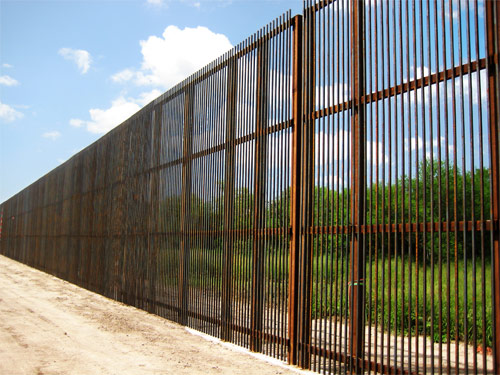
“Border Cantos,” an extremely moving collaboration between Richard Misrach and Guillermo Galindo, opened in the San Jose Museum of Art from February 26 to July 31, 2016, and has been covered in the California Sunday Magazine and National Public Radio‘s All Things considered. Galindo’s eloquent musical instruments and performances created from objects found on the border were too moving to be addressed in this post. They can be explored at his website, as well as at the exhibit website.
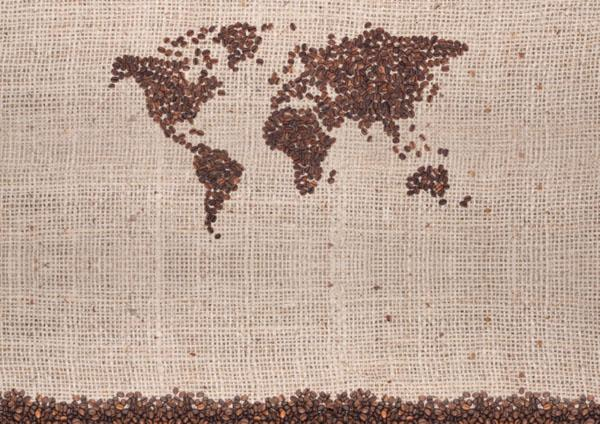
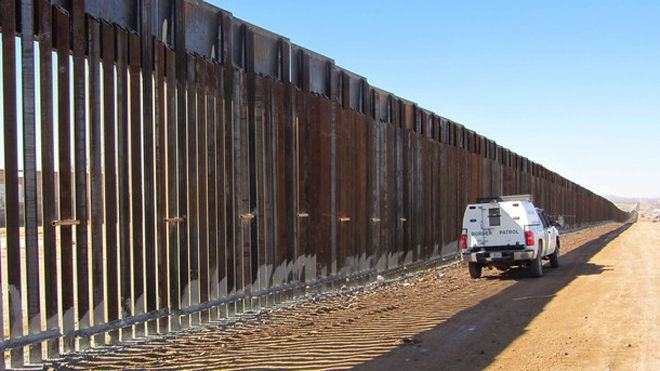



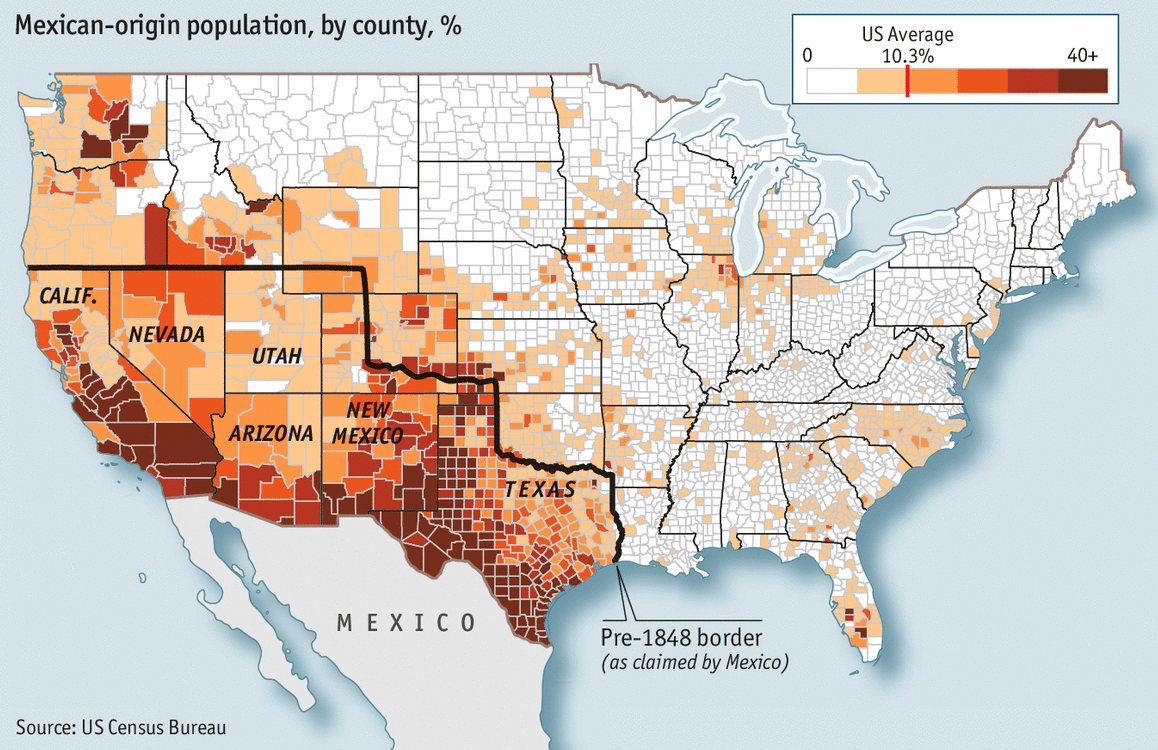
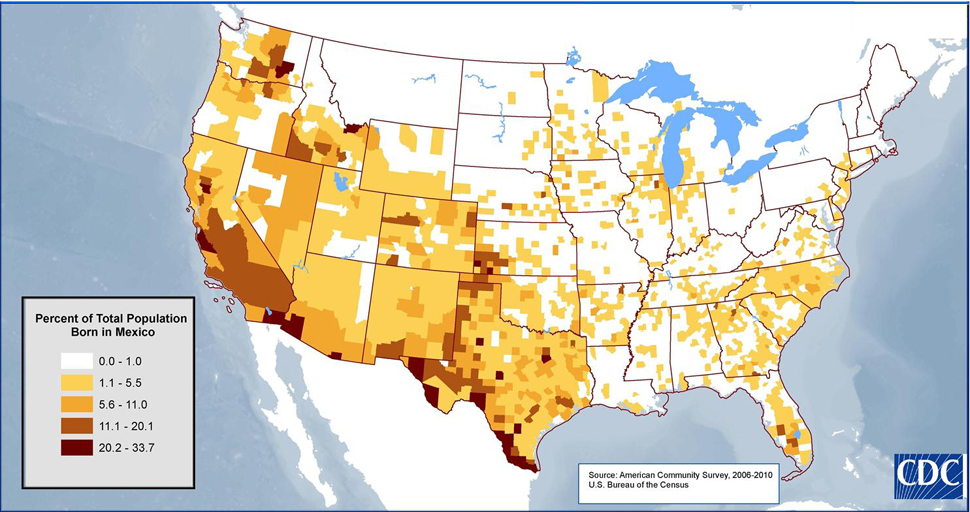






What a load of liberal horse shit. Give them humanity and jobs so they can take your jobs.
Human rights do seem important. One hopes this isn’t just a zero-sum game.
Pingback: Mapping Bannon’s Ban | Musings on Maps
Pingback: Strongman on the Border | Musings on Maps
Pingback: Mapping the Promise of the Border Wall | Musings on Maps
Pingback: Robert Steele: How Our Military Can Help Defend the Border – Truth and Liberty Blog
Pingback: Robert David Steele, How Our Military can help Defend Our Border - James Fetzer